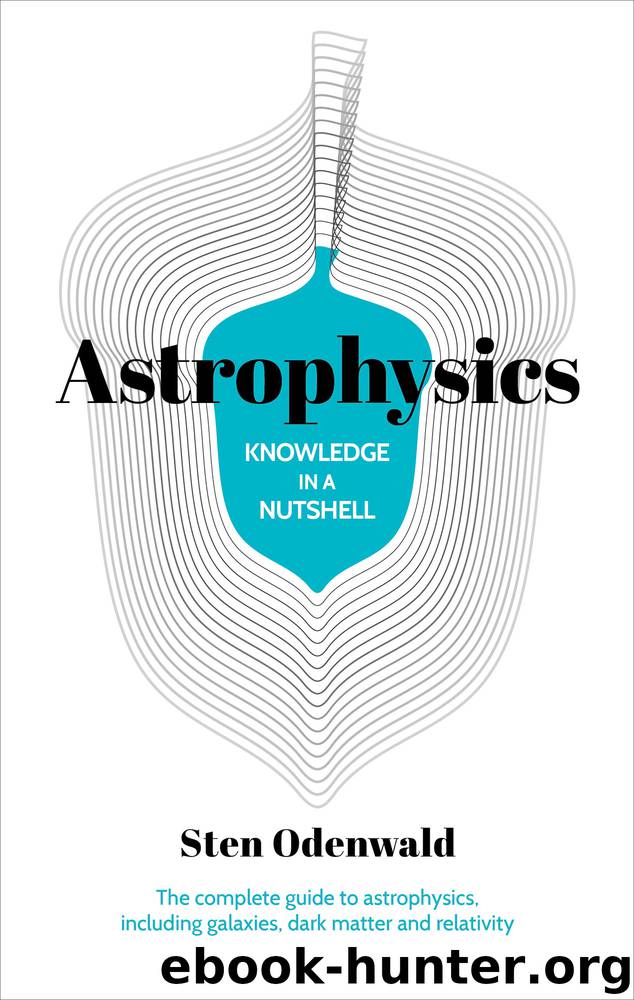Astrophysics by Sten Odenwald

Author:Sten Odenwald
Language: eng
Format: epub
Tags: Astrophysics
ISBN: 9781838577575
Publisher: Arcturus Digital Limited
Published: 2019-07-16T13:47:54+00:00
Main Sequence Stars (0.4 to 2 Msun)
These stars span the spectral classes from red dwarf M-type stars to very hot A-type stars. The evolution of these stars is extremely complex because as hydrogen fuels become insufficient to prevent gravitational collapse, other nuclear fuels step in as the core temperature increases to alter the progress of evolution. Also, the primary source of energy generation can move temporarily from the core to fuel-rich zones surrounding the core. This also changes the structure and size of the star. The stars in this mass range represent the vast majority of the stars in the Milky Way and evolve in roughly the same way, though the details depend very sensitively on the mass of the star.
When the abundance of hydrogen fuel in the core is depleted by about 20 per cent, the star has already grown slightly in luminosity and size because the steady collapse of the core heats it up and so the fusion reactions run more vigorously. This causes the star to slowly expand. Eventually, the region surrounding the core reaches the triggering temperature for fusion and, from this time forward, hydrogen ‘shell burning’ starts to produce more energy than the core so the star begins to expand rapidly and its outer layers cool. The star has now become an evolving red giant, and will steadily grow in radius and luminosity as its surface temperature remains roughly constant. Meanwhile, these reactions continue to shower the core region with inert helium ‘ash’, which is a by-product of hydrogen fusion. The massive ash core increases in temperature through gravitational collapse until it is possible for three helium nuclei to fuse into a carbon nucleus, a process called the triple-alpha reaction.
For stars in this mass range, the triple-alpha reaction is triggered in a core of matter that is being held up by electron degeneracy pressure. Such a gas does not behave the same way as ordinary gases because instead of the pressure increasing as it is heated, the pressure remains exactly the same as the core heats up. The triple-alpha reaction is triggered literally in a flash, but all this does is to remove the degeneracy effect so the core can temporarily behave as a normal gas. Nevertheless, this has little effect on the star as a whole. With helium burning in the core and hydrogen burning in the shell region, the star has reached its largest size as a red giant. From now on, as the helium is depleted in the core, and with no further fusion sources available to it, the core returns to a degenerate state and the star dramatically contracts in size. Eventually, it will lose its outer layers as a planetary nebula, with only its dense hot degenerate, carbon-rich core left behind as a dim ‘white dwarf’ no larger than our Earth.
Download
This site does not store any files on its server. We only index and link to content provided by other sites. Please contact the content providers to delete copyright contents if any and email us, we'll remove relevant links or contents immediately.
| Aeronautics & Astronautics | Astronomy |
| Astrophysics & Space Science | Comets, Meteors & Asteroids |
| Cosmology | Mars |
| Solar System | Star-Gazing |
| Telescopes | UFOs |
Turbulence by E. J. Noyes(7031)
Tools of Titans by Timothy Ferriss(6934)
Astrophysics for People in a Hurry by Neil DeGrasse Tyson(4613)
Room 212 by Kate Stewart(4099)
Pale Blue Dot by Carl Sagan(3995)
The David Icke Guide to the Global Conspiracy (and how to end it) by David Icke(3875)
Secrets of Antigravity Propulsion: Tesla, UFOs, and Classified Aerospace Technology by Ph.D. Paul A. Laviolette(3430)
Apollo 8 by Jeffrey Kluger(3196)
Losing the Nobel Prize by Brian Keating(3184)
A Journey Through Divination and Astronomy by Publishing Pottermore(3026)
Goodbye Paradise(2949)
COSMOS by Carl Sagan(2944)
Brief Answers to the Big Questions by Stephen Hawking(2872)
How to Read Water: Clues and Patterns from Puddles to the Sea (Natural Navigation) by Tristan Gooley(2849)
The Five People You Meet in Heaven by Mitch Albom(2834)
The Order of Time by Carlo Rovelli(2708)
How to Read Nature by Tristan Gooley(2657)
A Brief History of Time by Stephen Hawking(2470)
Aliens by Jim Al-Khalili(2376)
